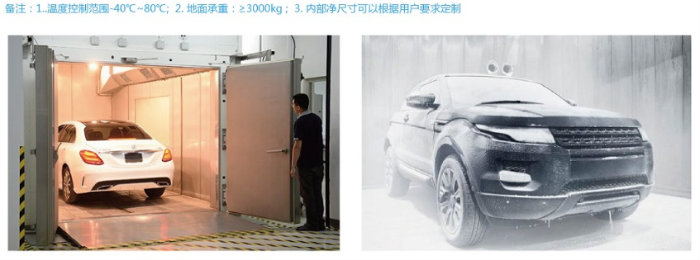-
Service Hotline:
021-39126000
4008207680 -

The main test items of the environmental test of automotive electronic products include:
(1) Power supply environment test: including DC, superimposed AC voltage, slow drop and slow rise of power supply voltage, power supply voltage termination, reverse voltage, open circuit test, short circuit protection, withstand voltage, insulation resistance and electromagnetic compatibility performance, etc.
The main test items of the environmental test of automotive electronic products include:
(1) Power supply environment test: including DC, superimposed AC voltage, slow drop and slow rise of power supply voltage, power supply voltage termination, reverse voltage, open circuit test, short circuit protection, withstand voltage, insulation resistance and electromagnetic compatibility performance, etc.
(2) Mechanical environment test: including sinusoidal vibration. Random vibration, mechanical shock, free fall, surface strength/scratch and surface friction, sand and gravel impact, etc.
(3) Climate environment test: including constant temperature test, temperature change test, temperature cycle test, ice-water shock test, salt spray test, damp heat cycle test, constant damp heat test, mixed gas overflow corrosion test, solar radiation test, etc.
(4) Chemical environmental test: refers to the components and parts that may come into contact with the specified chemical reagents should be able to resist the corrosion of these reagents.
The automobile comprehensive experimental cabin provides automobile manufacturers with tests of various performance indicators in product development. The test cabin is mainly composed of cabin transfer protection structure, air conditioning system, fresh air system, dynamometer system, exhaust emission system, solar irradiation system and other parts.
GB1835203-2005排放試驗 | GB/T658-2000空調試驗 | GB18233-2003燃料消耗試驗 |
GB/T12542-1990熱平衡試驗 | GB/T12781-1991汽車供油系統氣阻試驗 | GB/T12546-1990汽車隔熱通風試驗 |
GB/T127826-1991汽車采暖試驗 | GB/T12781-1991汽車供油系統氣阻試驗 | GB/T12546-1990汽車隔熱通風試驗 |
GB/T12544-1990******車速試驗 | GB/T12543-1990加速試驗 | GB/T12536-1990滑行試驗 |
GB/T12546-1990最低穩定車速試驗 |
汽車綜合環境艙相關技術參數
1.溫度控制測試 | (1).溫度范圍:-40℃∽80℃;(2)溫度精度:當汽車靜止時,艙內氣溫均勻度保持±2℃受被試驗車熱負荷沖擊時,能在設定溫度內平穩控制,車前0.5米控制點氣溫波動<±1℃,一般控制點氣溫波動<±2℃,溫度-40℃至60℃范圍內艙壁上無凝結現象;(3)排放試驗:絕對溫度(H)5.5≤H≤12.2gH2o/kg空氣(4)歐3/4VI型試驗時:艙內整個試驗期間濕度應足夠低,以防止水在底盤測供機轉鼓上凝結。(5)變溫時:保證不結霜。(6)性能試驗:試驗艙氣溫25℃時,相對濕度50%RH±5% |
2.試驗負載范圍 | (1)整車******外形尺寸:7000*2200*2100mm,可按要求訂制;(2)整車******裝備重量:4000KG;(3)發動機******功率:300KW;(4)整車******吸氣量:720m3/h;(5)整車******排氣量:3200m3h,排氣管出口最高溫度350℃;(6)整車******散熱量:300KW;(7)轉鼓跟蹤風機:功率100KW,風速260KW/h風量300000m3/h.(8)新風供給量:-40℃∽10℃時,新風量大于1000m3/h;-10℃∽0℃時,新風量大于2500m3/h;0℃∽20℃時,新風量大于3500m3/h;20℃∽30℃時,新風量大于5000m3/h. |
3.濕度控制測試 | 滿足QC/T658-2000標準要求:38±1℃時,濕度為50%RH±5%,連續運行>1小時;(2)高溫試驗技術要求:+15∽60±1℃時,濕度為68±5%RH,連續云還行;溫度為30℃時,汽車急速狀態,整車******散熱量為25KW,******相對濕度達到90±5%RH,連續運行>1小時;(3)試驗中環境溫濕度,可跟蹤負荷變動,能在設定濕度內平衡控制溫度變化速率速測試:由常溫升溫至+60℃最長時間:不大于3H;→常溫降溫至-40℃最長時間:不大于3H。 |
4.艙內大氣壓測試 | 保證被試車穩定運行時艙內為微正壓(短時負載),設有氣壓平衡裝置,艙內日照測試: |
5.艙內操作測試 | (1)系統具有自動控制/手動控制的雙重操作功能; |
6.安全監測系統 | 試驗室除以壓力平衡和氧濃度、廢氣濃度控制新風外,還配備了以下安全措施: |
7.尾氣排放系統 | 汽車標準排放試驗艙
|
